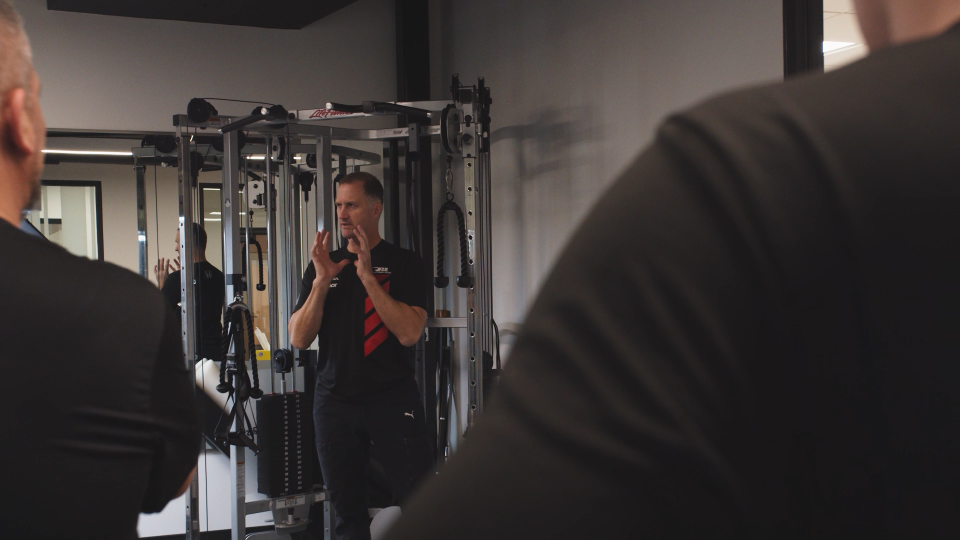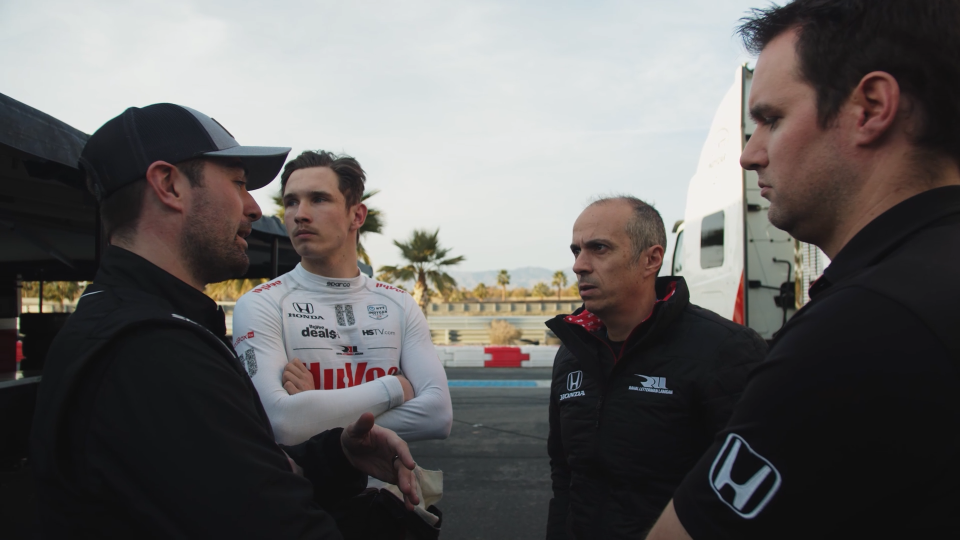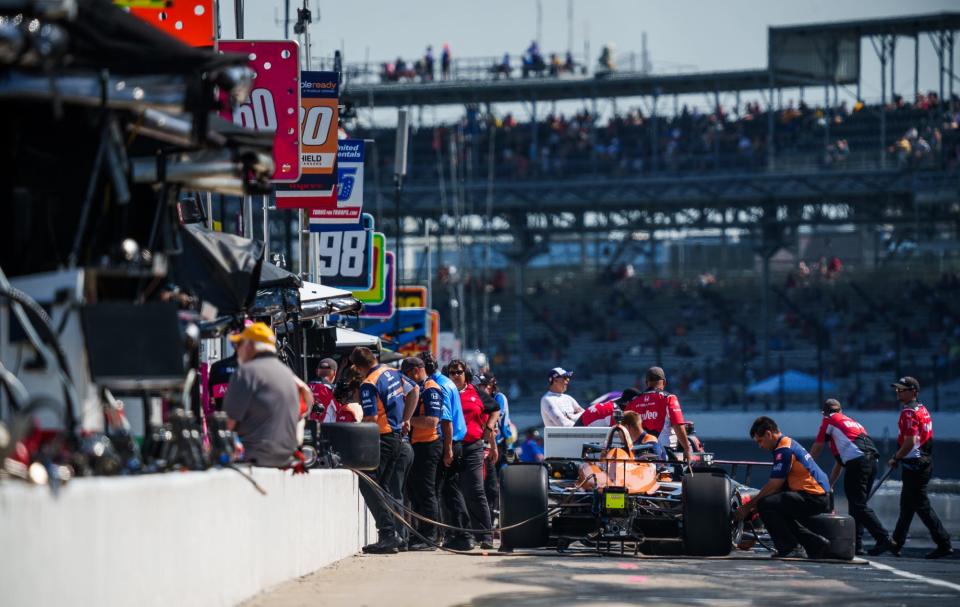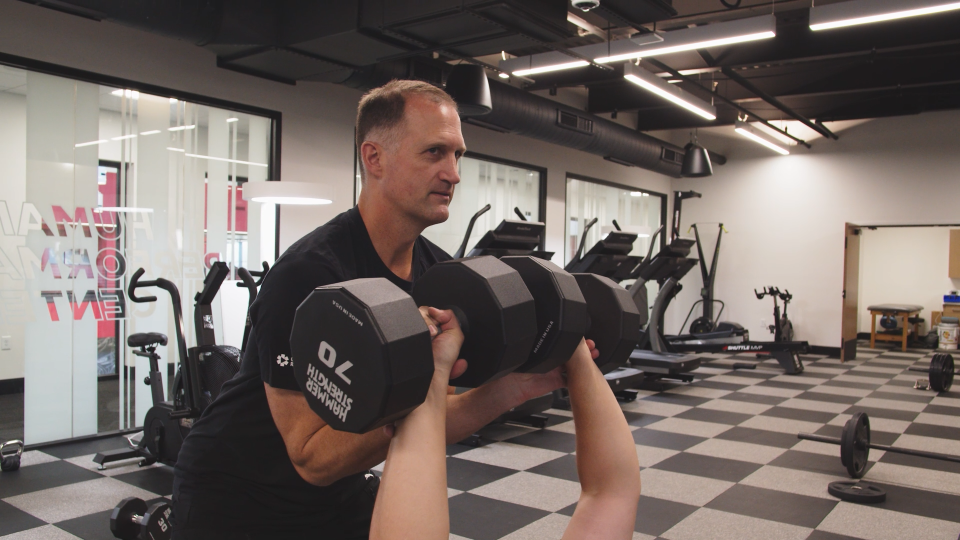Pickleball, sauna & $4,000 lamps: Inside Rahal Letterman Lanigan Racing's offseason overhaul
ZIONSVILLE – Rahal Letterman Lanigan Racing hired a veteran engineering mind from the Formula 1 world this offseason, but its secret to rebounding from a dismal 2022 IndyCar campaign may be a 45-year-old ex-minor league baseball pitcher.
Ryan Harber believes in the mental fortitude a tire changer can build from sitting in a sauna for 15 minutes. He sees a benefit in a 22-year-old linking up with a new coworker older than his father for a game of doubles pickleball in the team’s new shop in Zionsville. And he lives for sleep studies centered around the benefits of absorbing a special type of light emitted from $4,000 lamps.
Harber’s a one-of-one in the IndyCar paddock, quietly hired by RLL in January 2022. He will readily tell you he often fails at properly juggling his three roles (athletic trainer, strength and conditioning specialist and pit stop coach). Failure or not, Harber’s unique skillset couldn’t be more vital for a team heavily invested in a rebound campaign for its three full-time cars. RLL lacked speed early in 2022, confidence in the Indianapolis 500 and, when it began to find results late last summer, the consistency to make them stick.
“We need to learn how to become a team, and we weren’t that last year,” Harber told IndyStar, seated on a workout bench during a recent trip to the team’s shop. “We had 21 new people, and no one had any chemistry. We just had a bunch of individuals.
“And I think everyone refuses to have another season like we had last year.”

The art of 'process and methodology'
The new hire you’ve likely heard of – new technical director Stefano Sordo – brings plenty to the table, too. The ex-McLaren F1 director of vehicle performance spent nearly 22 years with Arrows, Jaguar, Toro Rosso (now Alpha Tauri), Red Bull and McLaren. Sordo spent the most formative of those years working under one of modern-day F1’s most illustrious engineering minds, Adrian Newey, who wrote a book titled, “How to Build a Car: The Autobiography of the World’s Greatest Formula 1 Designer.”
Spend even 90 seconds with Sordo, and his mindset is crystal clear: He arrives in IndyCar with a bag of tricks most would say are next to impossible to use on a team whose staff is closer to 50 than 500. It’s Sordo’s goal to prove those doubters wrong.
Career mortality:Graham Rahal talks career trajectory, life beyond racing
“I know we can understand the car better. I’ve seen the power of understanding – wind tunnel data, CFD (computational fluid dynamics) data, testing data. I’ve seen how powerful that all can be,” he said. “We can have a simulation package that, if used properly, can be exactly the same as an F1 simulation package. For sure it’s less-refined, and perhaps the model is less accurate, but it’s really about the process and methodology.
“I don’t see why it should be any different.”

In laymen’s terms, Sordo believes that, even after more than a decade spent tinkering with the DW12 chassis in its various forms, there are still stones left to uncover – particularly from an engineer who’s spent his working life shaving tenths of seconds off F1 machines more expensive and refined. To find a few hundredths a lap here and there, he strongly believes, should be more than reasonable.
“The same physics that apply to F1, they apply to IndyCar, too,” he continued. “We’re going to use the simulator a lot more to make sure we understand what we have, because if we don’t, then it’s difficult to optimize it."
Even in a phase of expansion, it’s all about doing a couple of core things better – and in some cases, changing those core things entirely. As Harber cares for the team’s dozens of employees from his storage room-turned-training-facility, he couldn’t be more in-sync. Because if he has his way, the progress RLL’s tire changers, front-end mechanics and marketing managers achieve in Harber’s health and wellness corner of the building will bleed into each facet of RLL’s growing race team.
It all starts with an early morning stretch.
Cultivating trust and building strength
After five years touring the minor leagues as a pitcher who never rose above High-A ball, Harber soon made his way back to central Indiana and became a certified athletic trainer with St. Vincent Sports Performance. Two years later, in May 2004, the Butler grad joined a team dedicated to traveling the IndyCar circuit on a contract basis for various teams and drivers. For 18 seasons, he worked with some of the sport's legends.
RLL offered him a full-time home. “And I’ve truly found I like being part of a team again,” he said.
Race predictions for 2023:Scott McLaughlin's 1st title, Scott Dixon's Indy 500 redemption
Changes for 2023:IndyCar to run alternate oval tires, pause for red flags in qualifying
Part of that, he discovered midway through last year’s frustrating season in which RLL's drivers finished 11th, 14th and 22nd in points, was showing his new coworkers some tough love he trusted would result in long-term benefits. “We’d always have these team meetings first thing in the morning to go over details and schedules, and I started taking five minutes at the end for what I called morning mobility stretching sessions,” Harber explained. “A lot of the guys were upset because they didn’t want to be told what to do. That was, until they slowly realized, ‘Hey, I really do feel better after I do this.'
“The idea was, ‘If I can take five minutes of your time and show you it can be beneficial and make you feel better, you’re going to be willing to do more things for me.' And it’s worked.”
Welcome to our new HQ! @ZionsvilleIN | @RenierConstruct pic.twitter.com/chl3pO1bih
— Rahal Letterman Lanigan Racing (@RLLracing) November 1, 2022
Tuesday and Thursday mornings, you can also find him down from his perch of an office on the second floor in the massive garage space where RLL has carved out a mini straightaway meant for pit stop practice. A year ago, space constraints at the old Brownsburg shop made it difficult to practice.
“But guys would so often use the excuse, ‘We have too much car prep to do.’ This just wasn’t a priority,” he said. “Some of it, I think, was more about the cars not being competitive. You’re pounding around in 20th (most races). ‘Is the pit stop really going to matter, if we can come out 19th? Why am I going to put in all this effort just to run there?’”
That defeatist mindset, Harber said, slowly started to change as folks in each corner of the race team noticed gains in spending more time within his orbit.
The 45-year-old could be wearing any one of three hats. As a certified athletic trainer, he’s trained to evaluate, treat and manage any range of muscular and skeletal injuries. To complement his work, Harber has contracted both a chiropractor and a massage therapist that visit the shop once a month to treat acute and chronic issues beyond his line of work. Additionally, an orthopedic physician is available every other week for routine check-ups those in the go-go-go world of racing would’ve put off until the offseason – and then skipped.

As their certified strength and conditioning specialist, too, “Now I know, ‘Hey, you’ve got that left shoulder issue,’ so I know everything that’s going on, what we need to be staying away from – and I don’t have to just trust another strength coach,” he said.
Combine that with his role as the team’s pit stop coach, and he can take his knowledge to fit the team’s needs. Even pit stops, he says, have reached the age of data analytics and video breakdowns.
“Not only can I pinpoint where exactly we’re losing time, but I can see, ‘Is this a true strength issue, where they’re just weak in certain areas? Is it a hand-eye coordination thing, where we need to work on reaction and timing? Or is it their talent?” Harber said.
'Get up here and work'
Harber estimates that right off the bat near the start of last season, he had 80-85% buy-in from the team’s over-the-wall crews, where, outside the drivers, achieving and maintaining peak physical fitness is pivotal. But those four or five holdouts were tough to crack.
“There’s a lot of old, grumpy people in this sport that don’t like change, but all it takes is one or two guys on the shop floor talking, ‘Hey, this program really works,’ and they’re holding each other accountable,” he said. “If three or four guys on the car are coming up here and working out with me, and two aren’t, they’re saying, ‘Get your (butt) up here and workout with me.’"
As that dedication and grit has spread, he explains, it’s common to see those former holdouts stepping into the team’s in-house sauna that can reach 167 degrees for 10-15 minutes that, Harber explains, is meant to stretch their comfort zones for steamy races like this week’s season-opener in St. Pete.
Harber was on-hand with St. Vincent for IndyCar’s race at Texas Motor Speedway in June 2020 when nearly two-dozen paddock members needed serious medical attention that included 44 bags of IVs. “No one had been in any heat, and it’s the first time a lot of folks are wearing a mask, and they weren’t acclimated to it,” Harber said of the temperatures that topped 100 degrees in the middle of the pandemic. “It’s deliberate heat exposure. You’re putting yourself in an uncomfortable environment, and your brain is telling you to get out, and you have to sit there, breathe, calm yourself down and sit and navigate it.
“And that’s just like when you go over the wall. You’re uncomfortable, not in control. Your heart rate goes through the roof, and what do you have to do? Calm yourself down, breathe and navigate through it.”

His methodology, you might argue, stretches to the extreme: RLL’s workout space is outfitted with four special lamps purchased from the boutique Swedish company BrainLit. As Harber explains, the human body thrives on early-morning sunlight to help regulate the timely release and suppression of cortisol and melatonin that power us through the work day and then allow us to recharge at night. An over-worked engineer pushing through 12-hour shifts in the shop is more likely to miss those peak sunlight hours in-season. In the winter? Even someone arriving at 8 a.m. and leaving at 5:30 p.m. is deficient. And additional time spent scrolling one’s phone before bed – and the blue light your body absorbs – only worsens that delicate balance.
“Photon energy is measured in ‘lux,’ and you want to get 100,000 before 10 a.m. These lights give off 10,000 a minute to anyone within 10 feet of them,” Harber says, pointing to the lamps strategically placed near the dumbbell racks and core workstations. “Stand near these for 10 minutes, and you’ve got all the sunlight you need in a day.”
Featured during their stint on HBO's 'Hard Knocks' last preseason, the Detroit Lions tracked the sleep quality of various staff members with the lamps in their offices and within a couple months tracked consistent 20% ‘sleep score’ improvement.
Will these $4,000 lamps, or winter happy hours spent bonding over pickleball, matter when it comes to Sunday afternoon in St. Pete? Even Harber says he can’t be sure. But after years spent working closely with Graham Rahal, he knows small mistakes in pitlane – in Rahal’s case, a tire not properly secured while leading past the halfway point of the 2021 Indy 500 that stole his best shot at immortality – can forever change a career.
“I don’t think I’m the magic pill here. There’s plenty of other organizations that have bigger or more expensive weight rooms, but you’ve got to get them to want to come in here and challenge themselves,” Harber said. “They’ve been tinkering with these cars going on six years now. How many advantages can we find? From a human standpoint, if we have more energy and focus throughout the day, maybe it just comes down to someone not making a mistake.”
This article originally appeared on Indianapolis Star: IndyCar: Rahal looking outside-the-box to rebound from disappointing 2022

